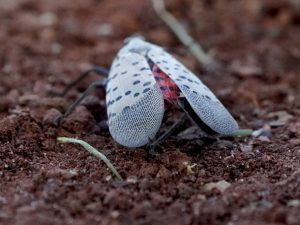Spotted lanternflies are still a pest, but the smoky honey they help make could be good for you
By Erin Negley | LNP / LancasterOnline

A spotted lanternfly creeps on the ground during a baseball game in Pittsburgh in 2021. Keith Srakocic / AP
In the years Matthew Libhart’s raised bees, he’s learned how to care for his hives.
He’s learned you can suggest and nudge honeybees, but you can’t make them do anything.
A few years ago, he learned they can make a new type of honey.
Libhart removed boxes filled with honey from the hives at his Warwick Township home right on time. Usually by July, the bees start to eat what they’ve stored. However, the bees were still making honey, building more comb in crevices, filling it with dark nectar. Libhart put a few empty boxes back.
“They filled them up,” he says. “And I’m like: What is this?”
Later he learned the late-season dark honey comes from Pennsylvania’s least-wanted pest: the spotted lanternfly. Since the bug showed up in Pennsylvania about a decade ago, they’ve killed grapevines and harmed other plants and trees. Bees didn’t get the “kill on sight” memo and the new honey has been one sweet side to spotted lanternflies. New research from honey samples including Libhart’s shows it has medicinal potential as well as a fall flavor for foodies.
“This is just the beginning of this research,” says Robyn Underwood, Penn State Extension apiculture educator.
A pest’s problems
Spotted lanternflies are native to China and have few natural predators in Pennsylvania, where they were spotted in 2014. The ag industry has asked people to stomp, swat and kill to slow the spread. Still, the insects have spread from the ground zero of Berks County throughout Pennsylvania and beyond.
The insects prefer the tree of heaven but will feed on more than 170 plant species, Underwood says.
The feeding can kill grapevines and is especially harmful to hops, kiwi and cucumber plants, according to new research from Penn State. The research also shows they aren’t harmful to hardwood trees like silver maple, weeping willow and river birch.
Yet also troubling is what the insects excrete: “honeydew,” sugary liquid that attracts sooty mold. The mold can stress plants and when covering a deck, for example, isn’t great for quality of life.
A silver lining
Insects, however, don’t mind the honeydew. Ants, fruit flies, butterflies and bees, including honeybees, eat it.
For honeybees, spotted lanternflies reach maturity just when their food sources start to disappear. Libhart was one of the beekeepers who didn’t have to feed his bees in the fall for a few years thanks to the lanternfly honeydew. It’s a silver lining to the pest, he says.
As the lanternfly numbers drop in Lancaster County, so has the free food for the honeybees. This fall, he’s back to feeding nearly all of his hives.
The honey made from the honeydew has been described as earthy and smoky.
Philadelphia Bee Co. made Doom Bloom honey, which it describes as a robust fall honey with a smoky flavor. A Philadelphia baker called it the “epitome of autumn.”
Libhart finds it difficult to describe.
“It’s got a kind of a weird taste that, at least in my experience, not too many people find palatable. I guess it’s kind of an acquired taste,” he says. “It kind of has a smoky, kind of maple-y taste to it, which sounds great, but it is kind of odd when you’re expecting honey.”
Underwood is not a fan but she shares individual sticks for people to sample and give their opinion.
She’s also shared honey with researchers, who have tested the honey. In several labs, they’ve found it out-performs manuka honey, the honey approved by the Food and Drug Administration for wound treatment. The spotted lanternfly honey inhibits the growth of bacteria such as MRSA and E. coli.
“No wonder it tastes like crap,” Underwood joked to a group of beekeepers last week. “It’s medicine.”
She would love for chemists to study the honey further to learn more.
In the meantime, beekeepers in four corners of Pennsylvania are taking weekly honey samples to find lanternfly DNA, led by The Grozinger Lab at Penn State. Honeybees could be the smallest scouts, discovering where the pests move before people notice.
We are here to share current happenings in the bee industry. Bee Culture gathers and shares articles published by outside sources. For more information about this specific article, please visit the original publish source: Spotted lanternflies help make smoky honey. It could be good for you. | 90.5 WESA








